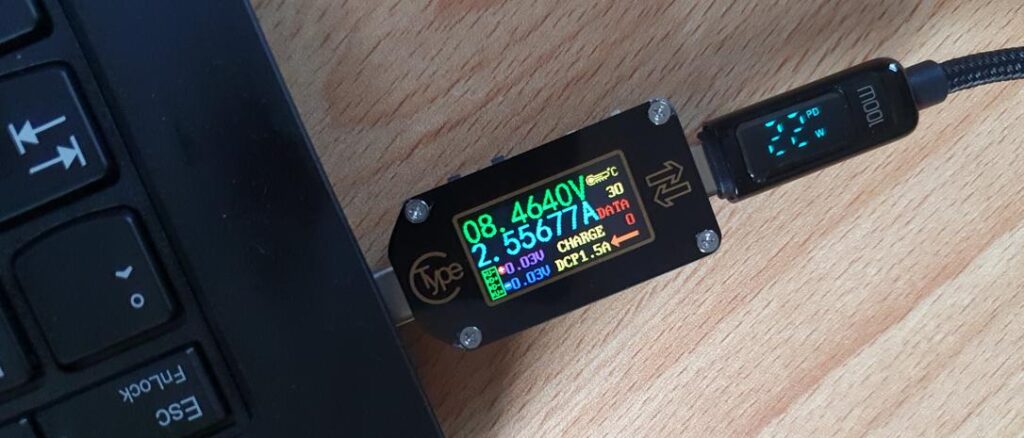
A couple of months ago, I discovered a USB Power Delivery (PD) cable that came with a little LCD display, so one could actually see the amount of power delivered over the cable. In the meantime, I’ve bought a couple of them because this is very useful. But they only show the power, no voltage and no overall power consumption over time. Also, I can’t measure power delivered by older power supplies with a USB-A connector or over USB PD cables that are permanently attached to a power supply. But I recently discovered a USB-C to USB-C USB PD tester with a small display that can do all of this: The JC-TC66C for around 35 euros.
This USB dongle has a USB-C input and a USB-C output that is rated for voltages of up to 20V, and can measure power going through a cable of up to 100W, i.e. the maximum allowed by the current USB PD specification. When plugged-in between a charger or battery and a power sink such as notebook, smartphone or tablet, it shows voltage, current, power, accumulated amount of power delivered, and a number of other things. So exactly what I needed! There dongle can also send this data over Bluetooth to a Windows or Android App, but I didn’t try this feature, the data shown on the built-in display all I need.
There is also a mode to store the amount of power delivered when the dongle is unplugged, so the previous measurement(s) are not lost. This requires to switch to “data group 1” and one needs to consult the manual how that is done with the two keys. It’s also possible to rotate the display by 180 degrees, which is very handy in many situations. Again, the manual needs to be consulted to get the key combination.
Another useful feature the dongle comes with is that it shows in which direction the power is flowing. That’s handy because for whatever reasons, I’ve had it before that the notebook tried to charge the external backup battery over USB PD rather than the other way round. That’s kind of a bad surprise if one is not careful. The arrow on the display of this tool would show this instantly.
In addition, apart from the total power consumed, I find the voltage indication quite interesting. So far, I always assumed that a notebook needs a USB-C PD power supply that can deliver a voltage of 20V. But it turned out that this is not the case. With some PD power supplies that are limited to 25 Watts and a voltage of 11V, my Lenovo notebooks are happy to charge with 8 volts instead of 20. The picture at the beginning of the post shows this scenario. That was definitely an interesting find which leads me straight to another idea…